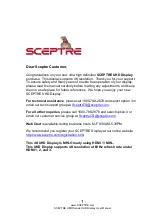
OPERATION
Decoding takes place on the AM/DP module of the ICC19 chassis, using two
MSP integrated circuits from ITT, and a DSP from Motorola. Operation is fully
digital.
MSP3410
This IS150 circuit is used as in chassis that are not equipped for Dolby
Prologic. It demodulates the FM or NICAM audio carriers received. It selects
the various inputs: AV1, AV2, AV3, AM-AF, FM, NICAM, according to the
configuration of the television set.
All incoming signals are digitised, while the analogue outputs from the IC come
from a digital-to-analogue conversion.
This circuit sends the Total Right and Total Left signals, and receives the
Centre signal, via Bus I2S.
The MSP3410 controls the headphone output, as well as the right and left
outputs of the TV speakers, used as a Centre effect in Dolby Prologic Mode.
DSP 56004
The Digital Sound Processor circuit works in a 24-bit internal format.
The management microcontroller loads the software that is used, under licence
from Dolby, via Bus I2C during the initialisation phase.
Using this program, the DSP generates four different channels, corresponding
to the channels of the Prologic system.
The centre signal returns to the first MSP. The background signal and the
external right and left channels are sent to the second MSP. These connections
are made via Bus I2S.
During installation, the DSP uses a program controlled by the microcontroller
to generate a sequence of noises for system configuration. The levels of the
various channels can thus be adjusted according to the user's set-up.
These adjustments are essential to obtain good results from the decoding of
Dolby Prologic.
The DSP is associated with 256-kbit RAM ID002, through which an adjustable
delay can be generated (Surround channel).
MSP3400
This circuit is different from the MSP3410 in the following two ways:
- This circuit does not perform NICAM processing,
- A second I2S bus input is wired in place of the SBUS input on the
MSP3410.
The FM demodulation stages are not used, and only the digital inputs are used.
The 18.432-MHz clock is the same as for the first MSP, to avoid clock
synchronisation problems between the two ICs.
The signal from the background channel enters the IC through the first I2S input
port. The signal from the right and left channels enters through the second I2S
port.
After processing that includes digital-to-analogue conversions, these signal are
available at the output. The right and left channels are output via the main
outputs of the IC, and the background channel is output via the outputs initially
intended for the headphones.
R/L* feedback is planned for MSP versions that perform the equaliser function.
CENTRE DE
FORMATION TECHNIQUE
143
143
Содержание ICC19
Страница 2: ...2 MENUS NAVILIGHT ...
Страница 3: ......
Страница 5: ...2 ...
Страница 6: ...3 GENERAL INFORMATION ...
Страница 7: ...4 ...
Страница 25: ...22 22 CENTRE DE FORMATION TECHNIQUE ...
Страница 59: ...56 56 CENTRE DE FORMATION TECHNIQUE ...
Страница 75: ...72 72 CENTRE DE FORMATION TECHNIQUE ...
Страница 81: ...78 78 CENTRE DE FORMATION TECHNIQUE ...
Страница 82: ...SWITCHING CONTENTS VIDEO SWITCHING AUDIO SWITCHING RGB SWITCHING CENTRE DE FORMATION TECHNIQUE 79 79 ...
Страница 91: ...88 88 CENTRE DE FORMATION TECHNIQUE ...
Страница 105: ...102 102 CENTRE DE FORMATION TECHNIQUE ...
Страница 127: ...124 124 CENTRE DE FORMATION TECHNIQUE ...
Страница 128: ...MEGATEXT OSD CONTENTS PROCESSING OF TELETEXT AND OSD CENTRE DE FORMATION TECHNIQUE 125 125 ...
Страница 131: ...128 128 CENTRE DE FORMATION TECHNIQUE ...
Страница 135: ...132 132 CENTRE DE FORMATION TECHNIQUE ...
Страница 141: ...138 138 CENTRE DE FORMATION TECHNIQUE ...
Страница 142: ...MODULE AUDIO WITH DOLBY PROLOGIC CONTENTS INTRODUCTION OPERATION CENTRE DE FORMATION TECHNIQUE 139 139 ...
Страница 147: ...144 144 CENTRE DE FORMATION TECHNIQUE ...
Страница 169: ......
















































